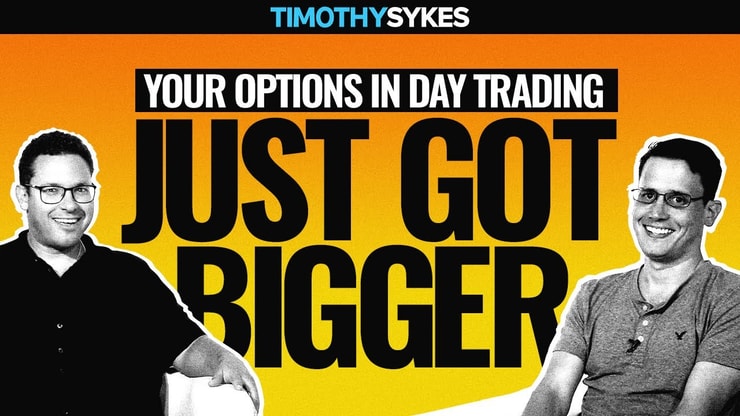Options trading is a form of derivative trading that allows traders to buy or sell the opportunity to engage in a future transaction on an asset, typically a stock, at a predetermined price. It’s a strategic tool that can be used to generate income, hedge against other investments, or speculate on the price of an asset. But remember, with high potential rewards come high risks.
Options trading is not for the faint-hearted. It’s a game of strategy, timing, and a bit of luck. But, if you’re willing to put in the work, it can be a lucrative investment strategy. This guide will walk you through the basics of options trading, from understanding what it is to executing your first trade.
Read on for my step-by-step guide on how to trade options, options strategies, investing questions about options products and services for stocks and shares — and options trades for every situation!
Table of Contents
What is Options Trading?

2025 Millionaire Media, LLCOptions trading is a form of derivative trading where a trader has the right, but not the obligation, to buy or sell a security at a predetermined price within a specified timeframe. It’s like a reservation at a restaurant – you have the option to go, but if you don’t show up, you only lose the reservation fee.
It’s crucial to understand the various platforms available to facilitate your options trading. For instance, you can explore some of the best options trading platforms to find one that suits your needs. Remember, the platform you choose can significantly impact your trading experience.
Benefits of Options Trading
Options trading offers several benefits.
- First, it allows investors and traders to hedge their portfolio against potential losses.
- Second, it provides the opportunity to generate income through premium collection.
- Lastly, it offers a high level of flexibility, allowing traders — seller or buyer — to profit from both rising and falling markets.
My millionaire student Mark Croock has adapted my penny stock strategies for the purposes of options trading. His Evolved Trader mentorship program is one I’d recommend for everyone — whatever step you’re on in your options trading journey, he’s got prudent, actionable advice and other content that will get you focused on the right things.
Check this interview out:
Risks Involved with Options Trading
However, options trading is not without risks. The most significant risk is the potential for substantial losses. If the market doesn’t move in the direction you predicted, you could lose your entire position.
Additionally, options trading can be complex and requires a high level of knowledge and experience.
Types of Options

2025 Millionaire Media, LLCThere are two main types of options: call options and put options.
Each type serves a unique purpose and can be used under different market conditions. To enhance your understanding, consider exploring other trading styles, such as day trading. You can start by learning about the trading platform for day traders and how it can benefit your trading activities.
More Breaking News
- Scholar Rock Flexes Muscles With Promising Developments
- Unexpected Surge for MARA Holdings: Analyzing the Latest Performance
- Azitra’s Clinical Progress: Investment Opportunity?
- Ford’s $5B Push: What This Means
Call Option
A call option gives the buyer the right, but not the obligation, to buy a stock at a specific price, known as the strike price, within a certain timeframe.
It’s like having a coupon that allows you to buy a product at a discount. If the market price of the stock rises above the strike price, you can exercise the option and buy the stock at a discount.
Put Option
On the other hand, a put option gives the buyer the right, but not the obligation, to sell a stock at a specific price within a certain timeframe.
It’s like having an insurance policy that allows you to sell your car at a predetermined price, regardless of its market value. If the market price of the stock falls below the strike price, you can exercise the option and sell the stock at a premium.
Long Option vs Short Option
In options trading, you can take a long or short position.
- A long position means you’re buying an option, expecting the price of the underlying asset to move in a certain direction.
- A short position means you’re selling an option, expecting the price of the underlying asset to move in the opposite direction.
Strike Price & Stock Price

2025 Millionaire Media, LLCThe strike price and the stock price are two critical components in options trading.
Strike Price Explained
The strike price is the predetermined price at which an option can be exercised. It’s like the price tag on a product – it tells you how much you need to pay to buy or sell the underlying asset.
The strike price is determined at the time the options contract is created and remains fixed throughout the life of the contract.
Stock Price and its Impact on Options Trading
The stock price, on the other hand, is the current market price of the underlying asset. It fluctuates based on supply and demand in the market. The relationship between the stock price and the strike price determines the value of an option.
If the stock price is higher than the strike price for a call option, or lower for a put option, the option is said to be “in the money.” If not, it’s “out of the money.”
Contract Fee & Time Frame
Options trading involves contract fees and time frames, both of which can significantly impact your potential profit or loss.
Types of Contract Fees for Options Trading
Contract fees, also known as premiums, are the cost of buying an option. They’re like the ticket price for a concert – you pay the price upfront, and in return, you get the right to enjoy the show (or in this case, the right to buy or sell a stock).
The amount of the premium depends on several factors, including the strike price, the time until expiration, and the volatility of the underlying asset.
Time Frame and its Impact on Options Trading
The time frame, or expiration date, is the date by which the option must be exercised. It’s like the expiry date on a coupon – after that date, the coupon is no longer valid.
The longer the time frame, the higher the premium, because there’s a greater chance that the market will move in your favor.
Trade Strategies & Positions
Options trading is not just about buying and selling options. It’s also about implementing strategies and managing positions to maximize profits and minimize losses.
It’s essential to choose a strategy that aligns with your investment goals and risk tolerance. To further expand your trading knowledge, consider exploring other trading tools. For instance, a stock trading app can provide you with real-time market data and help you make informed trading decisions.
Types of Trade Strategies for Options Trading
There are numerous trade strategies in options trading, each with its own risk and reward profile.
Some strategies, like buying calls or puts, are straightforward and suitable for beginners. Others, like iron condors or straddles, are more complex and suitable for experienced traders.
The key is to choose a strategy that aligns with your investment goals, risk tolerance, and market outlook.
How to Trade Options: A Definitive Guide

2025 Millionaire Media, LLCNow that we’ve covered the basics, let’s dive into the step-by-step process of trading options.
Determine Your Objective
Before you start trading options, you need to determine your objective. Are you looking to generate income, hedge your portfolio, or speculate on market movements? Your objective will guide your trading strategy and the types of options you trade.
Search for Options Ideas
Next, you need to search for options ideas. This involves researching and analyzing the market to identify potential trading opportunities. You can use various tools and resources, such as financial news, market reports, and trading platforms, to gather information and generate ideas.
My go-to weapon for finding plays? I use StocksToTrade — I even helped design it! This software is essential for finding trading opportunities.
There are two key tools on StocksToTrade you should know about — check the guides on my site:
These are my secret weapons in finding hot plays every day. The Breaking News chat room alerts me to important news articles in stocks and the overall economy, giving me a crucial trading edge.
In fact, roughly half of my recent trades have been direct effects of Breaking News.
Get a 14-day trial of Breaking News Chat here — only $17!
Pick Which Options to Buy or Sell

2025 Millionaire Media, LLCThe next step is to decide which options to buy or sell. This involves choosing the type of option (call or put), the strike price, and the expiration date. Your decision should be based on your analysis of the market and your trading objective.
Predict the Option Strike Price
Predicting the option strike price involves forecasting the future price of the underlying asset. This can be challenging, as it requires a deep understanding of the market and the factors that influence asset prices.
Determine the Option Time Frame
You need to determine the option time frame. This involves choosing the expiration date for the option. The time frame should be long enough to allow the market to move in your favor, but not so long that you overpay for the option.
Analyze and Compare Ideas
Once you have a list of options ideas, you need to analyze and compare them. This involves evaluating the potential risk and reward of each idea, considering factors such as the underlying asset, strike price, expiration date, and market conditions.
Manage Your Position
After you’ve executed a trade, you need to manage your position. This involves monitoring the market and adjusting your strategy as needed to maximize profits or minimize losses.
You may need to close your position early, roll it over to a later date, or double down if the market moves in your favor.
Why Trade Options?
Options trading offers several advantages over other forms of trading. It allows you to profit from market movements in either direction, provides a way to hedge your portfolio against potential losses, and offers the potential for high returns.
However, it also involves significant risks and requires a high level of knowledge and experience.
Key Takeaways

2025 Millionaire Media, LLCOptions trading is a complex but potentially lucrative investment strategy. It involves buying and selling options, which are contracts that give the holder the right, but not the obligation, to buy or sell a security at a predetermined price within a specified timeframe. Successful options trading requires a clear objective, thorough research, careful analysis, and diligent position management.
If you’re at the start of your options trading journey, I recommend getting some expert guidance. In the options world, I think there’s no better mentor than my former student Mark Croock.
Mark has racked up $4 million in career earnings, mostly from trading options. He’s done this by adapting my penny stock trading strategies to options. Before he was a teacher, he was one of my best students — watching every single webinar in my Trading Challenge 2 or 3 times!
Now he’s got his own mentorship program, called the Evolved Trader. Check it out for strategy sessions, trade alerts, a great chat room, and more!
Do you trade options? Let me know in the comments — I love hearing from my readers!











Leave a reply